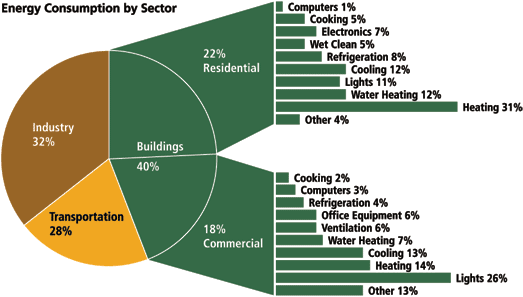Phase Change Composite Materials for Energy Efficient Building Envelopes
Introduction
In 2009, building operation was responsible for
about 30% of greenhouse gas emission and accounted for about 40% of
primary energy consumption globally [1]. Furthermore, greenhouse gas
emission from the building sector is expected to grow in the next
decades as a result of rapid economic growth [2]. Similar statistics
hold for the United States. In 2011, building operation accounted for
about 40% of total US primary energy consumption with 46% consumed by
commercial and 54% by residential buildings [3]. About 30 and 43% of
this energy was consumed for space heating and air conditioning in
commercial and residential buildings, respectively [3]. Therefore,
reducing the energy required for heating and cooling would
substantially improve building energy efficiency. To curb the energy
consumption of the building sector, the 2008 California long term
energy efficiency strategic plan established two major goals: (1) all
new residential buildings should be zero net energy (ZNE) by 2020 and
(2) all new commercial buildings by 2030 [4]. The European Union
established similar goals: (1) new buildings owned and occupied by
public authorities will be “nearly ZNE” by 2018 and (2) all new
buildings will be “nearly ZNE” by 2020 [5].
about 30% of greenhouse gas emission and accounted for about 40% of
primary energy consumption globally [1]. Furthermore, greenhouse gas
emission from the building sector is expected to grow in the next
decades as a result of rapid economic growth [2]. Similar statistics
hold for the United States. In 2011, building operation accounted for
about 40% of total US primary energy consumption with 46% consumed by
commercial and 54% by residential buildings [3]. About 30 and 43% of
this energy was consumed for space heating and air conditioning in
commercial and residential buildings, respectively [3]. Therefore,
reducing the energy required for heating and cooling would
substantially improve building energy efficiency. To curb the energy
consumption of the building sector, the 2008 California long term
energy efficiency strategic plan established two major goals: (1) all
new residential buildings should be zero net energy (ZNE) by 2020 and
(2) all new commercial buildings by 2030 [4]. The European Union
established similar goals: (1) new buildings owned and occupied by
public authorities will be “nearly ZNE” by 2018 and (2) all new
buildings will be “nearly ZNE” by 2020 [5].

No comments:
Post a Comment